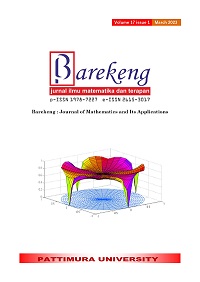OUTPUT VISUALIZATION FROM RESULT OF DISCRETE EVENT SYSTEM SIMULATION WITH ‘simmer’ R PACKAGE
Abstract
This study aims to describe the various capabilities of the simmer package on R, especially in running a discrete event simulation model of a circular system, then develop a DES simulation model building technique, which is effective and can represent real systems well, and explore the simulation output on this simmer, both in statistical summary form and parameter estimation. The method used in this research is the literature study with descriptive and exploratory approaches. Model development is more effective when it is carried out starting from simple models, to more complex forms step by step, and describing the system using a flow chart. Replication for simulations is easy to perform so as to get standard error values for model parameter estimators. The stages in developing a discrete event simulation model with a simmer, start with compiling a simple flowchart to a more complex form, and replication is carried out. The simmer output in the form of a data frame makes it very easy to process the output further. The simple R API on Simmer will also make it easier to simulate.
Downloads
References
D. N. Banks, Jerry, John Carson II, Barry Nelson, Discrete-Event System Simulation, 5th Editio. Edinburgh Gate, England: Pearson Education Limited, 2014.
R. E. Shannon, “Introduction to the art and science of simulation,” in 1998 winter simulation conference. proceedings (cat. no. 98ch36274), 1998, vol. 1, pp. 7–14.
M. Stark, “Why Data Visualization Is Important.” 2020.
H. A. A. Jiangjun Tang, George Leu, “Discrete Event Simulation,” Simulation and Computational Red Teaming for Problem Solving. pp. 121–142, Oct. 18, 2019. doi: https://doi.org/10.1002/9781119527183.ch7.
S. B. Ucar I, “simmer.plot: Plotting Methods for simmer. R package version 0.1.5,” 2017. http://r-simmer.org/extensions/plot.
I. Ucar, B. Smeets, A. Azcorra, U. Carlos, and I. I. I. De Madrid, “simmer: Discrete-Event Simulation for R,” vol. 90, no. 2, 2019, doi: 10.18637/jss.v090.i02.
I. G. A. A. Yudistira, “Pengembangan Simulasi Kejadian Diskret Berbasis Paket Simmer pada R,” Eng. Math. Comput. Sci. J., vol. 3, no. 2, pp. 79–85, 2021, doi: 10.21512/emacsjournal.v3i2.7386.
J. P. Lander, R for everyone: Advanced analytics and graphics. Pearson Education, 2014.
W. Chang, R graphics cookbook: practical recipes for visualizing data. O’Reilly Media, 2018.
W. N. Venables, D. M. Smith, and R. C. Team, “An introduction to R, Notes on R: A Programming Environment for Data Analysis and Graphics Version 3.6. 3.” R Foundation for Statistical Computing Vienna, Austria, 2020.
D. Ziniviev, Discrete Event Simulation. It’s Easywith SimPy! PragPub, 2018. [Online]. Available: https://www.researchgate.net/publication/322949363_Discrete_Event_Simulation_It’s_Easy_with_SimPy
P. Van Der Paelt, B. Lauwens, and B. Signer, “A Transparent Data Persistence Architecture for the SimJulia Framework”.
M. C. Sachs and E. E. Gabriel, “Event History Regression with Pseudo-Observations: Computational Approaches and an Implementation in R,” J. Stat. Softw., vol. 102, no. 9 SE-Articles, pp. 1–34, May 2022, doi: 10.18637/jss.v102.i09.
A. Ebert, P. Wu, K. Mengersen, and F. Ruggeri, “Computationally Efficient Simulation of Queues: The R Package queuecomputer,” J. Stat. Softw., vol. 95, no. 5 SE-Articles, pp. 1–29, Oct. 2020, doi: 10.18637/jss.v095.i05.
T. A. Syahputri, T. S. Az-zahra, N. A. Setifani, K. P. Ningrum, and D. Rolliawati, “PEMODELAN DAN SIMULASI PROSES PRODUKSI PERALATAN BAYI PADA HOME INDUSTRI PUPPY PUTRA PERDANA,” JUST IT J. Sist. Informasi, Teknol. Inf. dan Komput., vol. 11, no. 1, p. 24, Oct. 2020, doi: 10.24853/justit.11.1.24-31.
M. Tollefson, “Introduction: plot (), qplot (), and ggplot (), Plus Some,” in Visualizing Data in R 4, Springer, 2021, pp. 3–7.
X. G. Baqués, A. Mosca, B. Rondelli, and G. R. Fort, “Roman Open Data: A semantic based Data Visualization & Exploratory Interface,” Arqueol. y Téchne Métodos formales, nuevos enfoques Archaeol. Techne Form. methods, new approaches, p. 18, 2022.
Copyright (c) 2023 I Gusti Agung Anom Yudistira, Rinda Nariswari, Samsul Arifin

This work is licensed under a Creative Commons Attribution-ShareAlike 4.0 International License.
Authors who publish with this Journal agree to the following terms:
- Author retain copyright and grant the journal right of first publication with the work simultaneously licensed under a creative commons attribution license that allow others to share the work within an acknowledgement of the work’s authorship and initial publication of this journal.
- Authors are able to enter into separate, additional contractual arrangement for the non-exclusive distribution of the journal’s published version of the work (e.g. acknowledgement of its initial publication in this journal).
- Authors are permitted and encouraged to post their work online (e.g. in institutional repositories or on their websites) prior to and during the submission process, as it can lead to productive exchanges, as well as earlier and greater citation of published works.






1.gif)



